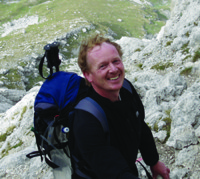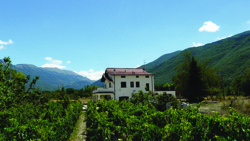Stuart Haines has long had a passion for exploring the Italian countryside on foot, and has written the Cicerone guidebook Walking in Abruzzo to share his experiences…
 What was your first experience of Italy?
What was your first experience of Italy?
It was as a geology student, searching the Alps above Domodossola for the elusive and beautiful mineral, kyanite. It was September and there were chestnut trees, mountain mists and herds of goats with bells. I was one of the few who could drive and was given responsibility for the university minibus. Negotiating hairpin bends over snowy passes at 1am with 15 drunk undergraduates bouncing around in the back was scary, but we survived.
So began my love affair with the mountains of Italy.
Can you tell us about your renovated property in Abruzzo?
My wife, Hil, and I found Casa La Rocca in 2007, having spent about three years looking for a home in the region. It’s a reconstructed farmhouse standing on the flat floor of the Sulmona Valley about 4km south of the town. We are set among fields, orchards and vineyards and ringed by mountains. It is a lovely spot – cool for most of the year but reliably hot in the summer, and cold for skiing in the winter. The place was habitable when we arrived but in need of lots of care and upgrading. Now all the big projects are done and the house is being enjoyed by us, our five daughters and our friends. We have made an independent apartment at the back which is popular with guests who come for the views, the peace, the heat (in the summer!) and adventures in the mountains (www.casalarocca.it).
How do you split your time between living abroad and the UK?
 Life is a great contrast between the rural quiet of Casa La Rocca and the city centre of Bristol. Our time in one place or the other is governed by the apartment-letting season and the vine-growing and wine-making cycle. We bottle about 350 litres of organic Montepulciano d’Abruzzo a year. In the UK, I work freelance from time-to-time as a project manager. Improvements in internet connectivity and changing attitudes to work location mean a fair amount of my project work can now be done in Italy.
Life is a great contrast between the rural quiet of Casa La Rocca and the city centre of Bristol. Our time in one place or the other is governed by the apartment-letting season and the vine-growing and wine-making cycle. We bottle about 350 litres of organic Montepulciano d’Abruzzo a year. In the UK, I work freelance from time-to-time as a project manager. Improvements in internet connectivity and changing attitudes to work location mean a fair amount of my project work can now be done in Italy.
What would you say makes walking in Abruzzo so appealing?
It is one of the wildest and least-populated regions of Italy, with 26 peaks above 2km, long mountain ridges, high plains and deep gorges, huge forests of native beech, oak and pine and gentle fertile valleys. The highest points in peninsular Italy and the southernmost glacier in Europe are here. This beautiful environment is maintained to a remarkable level in no less than three national parks, one regional park and many smaller reserves. In fact, almost a third of the region is protected – directly contributing to the wonderful wildlife.
What are some of your favourite walks in the region?
The Val di Rose in the Abruzzo National Park is a really beautiful mountain route where you have a great chance of spotting a chamois family. In the Majella National Park, the long ascent of Monte Amaro from Blockhaus is as fine as any subalpine route. The twisting ridge flanked by deep canyons leads to a whaleback summit. It’s a big walk, only really suited for a settled summer’s day, but the views will stay with you. A gentler circuit links the villages of Anversa degli Abruzzi and Castrovalva and, in the Gran Sasso, the hillside walk between Santo Stefano and Rocca Calascio gives you the best view in Abruzzo!
